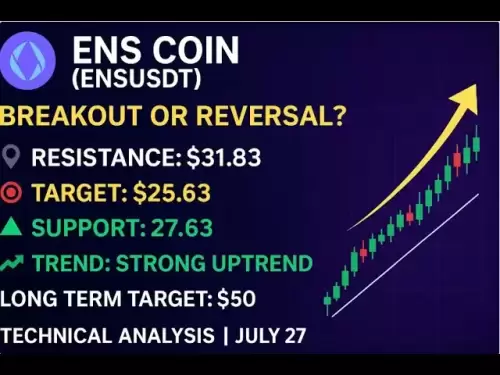-
 Bitcoin
Bitcoin $117900
0.31% -
 Ethereum
Ethereum $3766
0.28% -
 XRP
XRP $3.176
-0.31% -
 Tether USDt
Tether USDt $1.000
0.00% -
 BNB
BNB $795.6
1.51% -
 Solana
Solana $186.8
-1.09% -
 USDC
USDC $0.9999
-0.01% -
 Dogecoin
Dogecoin $0.2353
-1.33% -
 TRON
TRON $0.3226
1.49% -
 Cardano
Cardano $0.8172
-1.08% -
 Sui
Sui $4.178
3.06% -
 Hyperliquid
Hyperliquid $43.05
-3.39% -
 Stellar
Stellar $0.4367
-0.57% -
 Chainlink
Chainlink $18.62
1.47% -
 Hedera
Hedera $0.2828
6.63% -
 Bitcoin Cash
Bitcoin Cash $584.7
5.65% -
 Avalanche
Avalanche $24.81
2.53% -
 Litecoin
Litecoin $112.8
-0.88% -
 UNUS SED LEO
UNUS SED LEO $8.975
-0.08% -
 Shiba Inu
Shiba Inu $0.00001395
-1.07% -
 Toncoin
Toncoin $3.285
-1.05% -
 Ethena USDe
Ethena USDe $1.001
0.01% -
 Polkadot
Polkadot $4.123
0.76% -
 Uniswap
Uniswap $10.49
-0.18% -
 Monero
Monero $326.5
0.14% -
 Dai
Dai $0.9999
-0.02% -
 Bitget Token
Bitget Token $4.576
0.34% -
 Pepe
Pepe $0.00001247
-1.55% -
 Cronos
Cronos $0.1400
3.77% -
 Aave
Aave $295.1
-0.73%
Is there a limit on the issuance of USDT?
Tether (USDT), a dollar-pegged stablecoin, lacks a pre-set issuance cap; its supply adjusts to market demand, raising ongoing concerns about reserve transparency and the stability of its 1:1 peg.
Mar 07, 2025 at 05:18 am
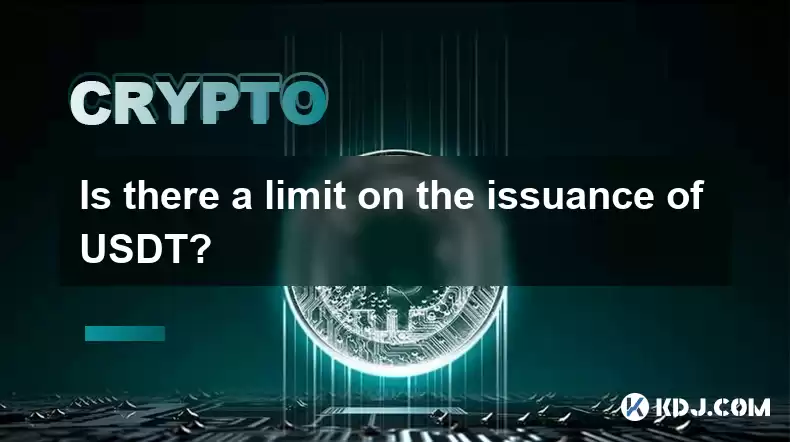
Key Points:
- Tether (USDT) is a stablecoin pegged to the US dollar, aiming for a 1:1 ratio.
- There's no pre-defined, hard cap on USDT issuance.
- Tether's issuance is driven by market demand and redemption requests.
- Transparency regarding USDT reserves remains a subject of ongoing debate and scrutiny.
- Understanding Tether's issuance mechanism is crucial for navigating the cryptocurrency market.
Is There a Limit on the Issuance of USDT?
The question of whether there's a limit on Tether (USDT) issuance is complex. Unlike Bitcoin with its fixed supply of 21 million coins, USDT doesn't have a pre-determined maximum. Its supply is elastic, meaning it expands or contracts based on market forces. This dynamic nature is a key feature differentiating it from other cryptocurrencies.
Tether's issuance is primarily driven by demand. When users want to buy USDT, Tether mints new tokens. Conversely, when users redeem their USDT for fiat currency, Tether burns (destroys) those tokens. This mechanism aims to maintain the 1:1 peg with the US dollar. The absence of a fixed limit allows for flexibility to meet fluctuating market demands.
The Mechanics of USDT Issuance and Redemption:
The process is relatively straightforward, though the details of the reserves backing the tokens remain a point of contention. Essentially:
- Issuance: When demand for USDT rises, Tether creates new tokens and adds them to circulation. This typically happens when users exchange fiat currency for USDT on exchanges.
- Redemption: When users want to cash out their USDT, they submit a redemption request. Tether then burns the equivalent amount of USDT tokens and transfers the corresponding amount of USD to the user.
Transparency and Reserves:
A significant concern surrounding USDT is the transparency of its reserves. Tether maintains that its USDT is fully backed by equivalent reserves, primarily in US dollars, but also other assets. However, the exact composition and verification of these reserves have been subjects of intense scrutiny and audits, leading to ongoing debates within the crypto community. The level of transparency provided by Tether has been a key factor in the discussions surrounding its stability and trustworthiness. Regular updates and reports regarding the reserves are published by Tether, yet complete transparency and independent verification remain areas of ongoing discussion and development.
The Impact of USDT's Uncapped Supply:
The lack of a hard cap on USDT issuance has both advantages and potential drawbacks. The flexibility allows it to cater to the ever-changing needs of the crypto market, providing liquidity for trading and facilitating transactions. However, the potential for uncontrolled expansion also raises concerns about inflation and the stability of the peg to the dollar. These concerns underscore the importance of transparent reporting and robust auditing practices to maintain confidence in the system.
The Role of USDT in the Crypto Ecosystem:
USDT plays a significant role in the cryptocurrency ecosystem, often acting as a bridge between fiat currency and cryptocurrencies. Its use as a stablecoin allows traders to mitigate volatility, store value temporarily, and easily transition between different cryptocurrencies. Its wide acceptance across various exchanges makes it a crucial part of the trading infrastructure. This prevalent usage further highlights the need for continued scrutiny of its issuance mechanisms and reserve management.
The Future of USDT Issuance:
The future of USDT issuance and its regulatory landscape remains uncertain. Regulatory bodies worldwide are increasingly focusing on stablecoins and their potential risks. Increased regulatory scrutiny could lead to changes in Tether's operations, potentially impacting its issuance mechanisms and reserve management practices. The evolution of Tether’s practices will significantly influence its future role in the cryptocurrency landscape.
Frequently Asked Questions:
Q: Is USDT truly backed by 1:1 USD reserves?
A: Tether claims its USDT is fully backed by equivalent reserves, but the exact composition and independent verification of these reserves remain a subject of ongoing debate and scrutiny within the crypto community. While Tether publishes regular reports on its reserves, complete transparency and independent verification are still under development.
Q: What happens if Tether runs out of USD to back USDT?
A: If Tether were unable to meet redemption requests due to insufficient reserves, it could lead to a loss of confidence in the peg, causing a significant drop in USDT's value and potentially destabilizing the cryptocurrency market. This scenario highlights the importance of robust reserve management.
Q: Can Tether just print unlimited USDT?
A: While there's no pre-defined limit, Tether's issuance is tied to market demand and redemption requests. Printing unlimited USDT without corresponding reserves would severely undermine the 1:1 peg and erode trust in the system. The practical limitations of maintaining the peg act as a constraint on uncontrolled issuance.
Q: How is the issuance of USDT regulated?
A: The regulatory landscape surrounding stablecoins, including USDT, is still evolving. Various regulatory bodies worldwide are increasingly scrutinizing stablecoins, leading to ongoing discussions about appropriate oversight and regulations for stablecoin issuers.
Q: What are the risks associated with investing in USDT?
A: While USDT aims for price stability, it's not without risk. Concerns regarding reserve transparency, regulatory uncertainty, and the potential for a loss of confidence in the peg all pose potential risks to investors. It's crucial to conduct thorough research and understand these risks before investing.
Disclaimer:info@kdj.com
The information provided is not trading advice. kdj.com does not assume any responsibility for any investments made based on the information provided in this article. Cryptocurrencies are highly volatile and it is highly recommended that you invest with caution after thorough research!
If you believe that the content used on this website infringes your copyright, please contact us immediately (info@kdj.com) and we will delete it promptly.
- Bitcoin, Ruvi AI, and CoinMarketCap: Navigating the Future of Crypto
- 2025-07-28 02:30:12
- Dogwifhat (WIF) Eyes Bullish Breakout: Can It Breach $1.20?
- 2025-07-28 02:50:12
- Bitcoin Bounces: How the US-China Tariff Truce Impacts Crypto
- 2025-07-28 02:50:12
- Bitcoin Bull Market: Price Targets and Expert Takes
- 2025-07-28 02:30:12
- Cardano Price Rockets: ADA Jumps Past Resistance, $2 Target in Sight?
- 2025-07-28 01:30:14
- Ruvi AI: The Next Solana? Riding the AI Token Wave on CoinMarketCap
- 2025-07-28 00:50:16
Related knowledge

How to choose a reliable USDT exchange service provider? How to identify?
Jun 12,2025 at 03:15pm
Understanding the Role of USDT in Cryptocurrency TradingUSDT (Tether) is one of the most widely used stablecoins in the cryptocurrency market. It is d...
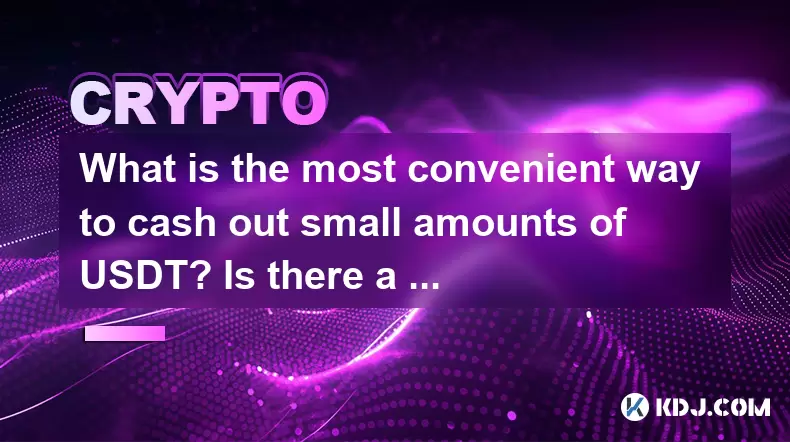
What is the most convenient way to cash out small amounts of USDT? Is there a shortcut?
Jun 11,2025 at 11:00pm
Understanding the Need to Cash Out Small USDT AmountsCashing out small amounts of USDT can be a challenge for many crypto users. Traditional methods o...
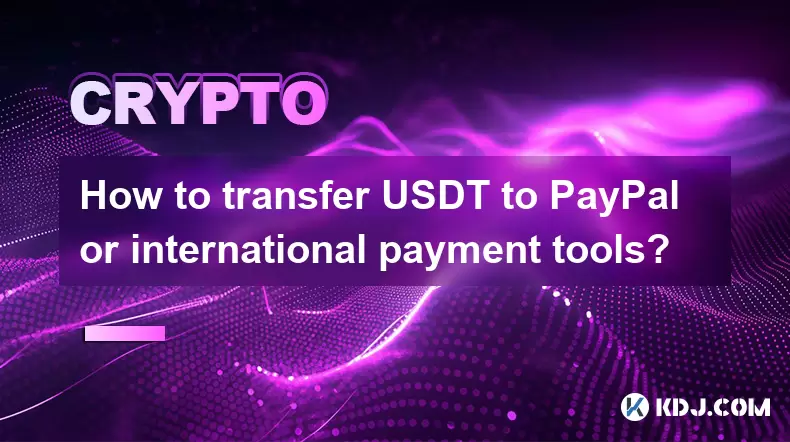
How to transfer USDT to PayPal or international payment tools?
Jun 15,2025 at 05:28am
Understanding the Basics of USDT and PayPal IntegrationUSDT (Tether) is a stablecoin pegged to the US dollar, offering blockchain-based value transfer...
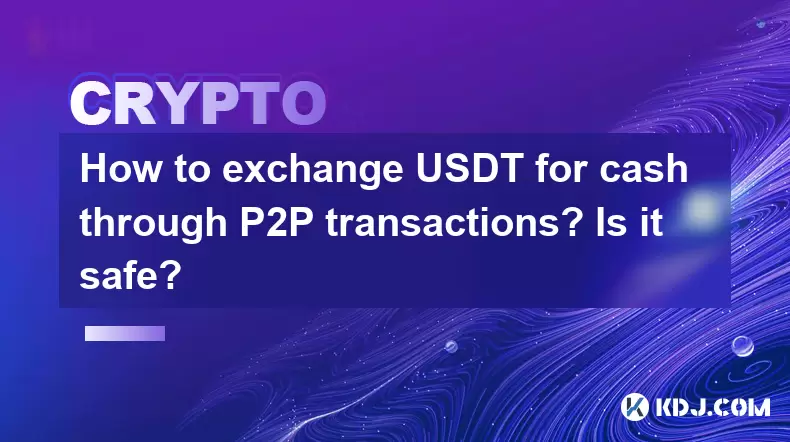
How to exchange USDT for cash through P2P transactions? Is it safe?
Jun 18,2025 at 07:56am
Understanding USDT and P2P TransactionsTether (USDT) is a stablecoin pegged to the value of the US dollar, making it a popular choice for users who wa...
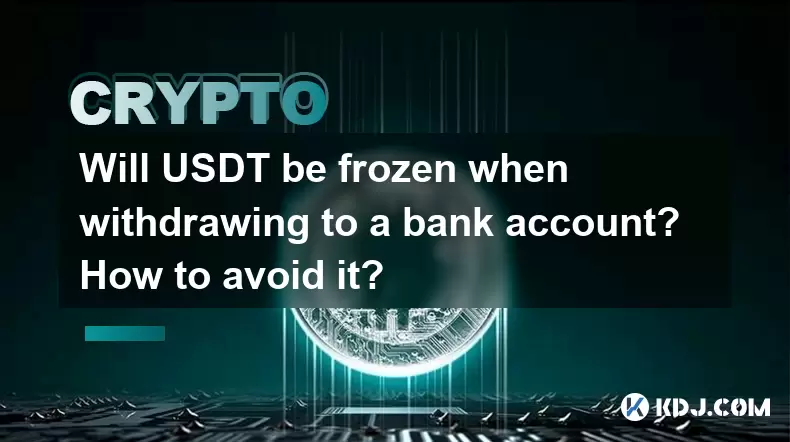
Will USDT be frozen when withdrawing to a bank account? How to avoid it?
Jun 15,2025 at 10:03am
Understanding USDT Withdrawals and Bank Account Freezing RisksWhen users decide to withdraw USDT (Tether) to a bank account, one of the most common co...

How to avoid risks when exchanging USDT for cash? What are the pitfalls?
Jun 11,2025 at 08:14pm
Understanding the Risks of Exchanging USDT for CashWhen exchanging USDT (Tether) for cash, users must be aware of the potential risks involved. As a s...

How to choose a reliable USDT exchange service provider? How to identify?
Jun 12,2025 at 03:15pm
Understanding the Role of USDT in Cryptocurrency TradingUSDT (Tether) is one of the most widely used stablecoins in the cryptocurrency market. It is d...

What is the most convenient way to cash out small amounts of USDT? Is there a shortcut?
Jun 11,2025 at 11:00pm
Understanding the Need to Cash Out Small USDT AmountsCashing out small amounts of USDT can be a challenge for many crypto users. Traditional methods o...

How to transfer USDT to PayPal or international payment tools?
Jun 15,2025 at 05:28am
Understanding the Basics of USDT and PayPal IntegrationUSDT (Tether) is a stablecoin pegged to the US dollar, offering blockchain-based value transfer...

How to exchange USDT for cash through P2P transactions? Is it safe?
Jun 18,2025 at 07:56am
Understanding USDT and P2P TransactionsTether (USDT) is a stablecoin pegged to the value of the US dollar, making it a popular choice for users who wa...

Will USDT be frozen when withdrawing to a bank account? How to avoid it?
Jun 15,2025 at 10:03am
Understanding USDT Withdrawals and Bank Account Freezing RisksWhen users decide to withdraw USDT (Tether) to a bank account, one of the most common co...

How to avoid risks when exchanging USDT for cash? What are the pitfalls?
Jun 11,2025 at 08:14pm
Understanding the Risks of Exchanging USDT for CashWhen exchanging USDT (Tether) for cash, users must be aware of the potential risks involved. As a s...
See all articles
























